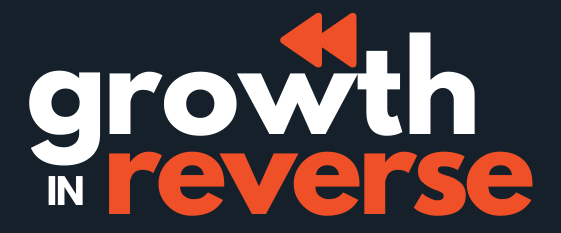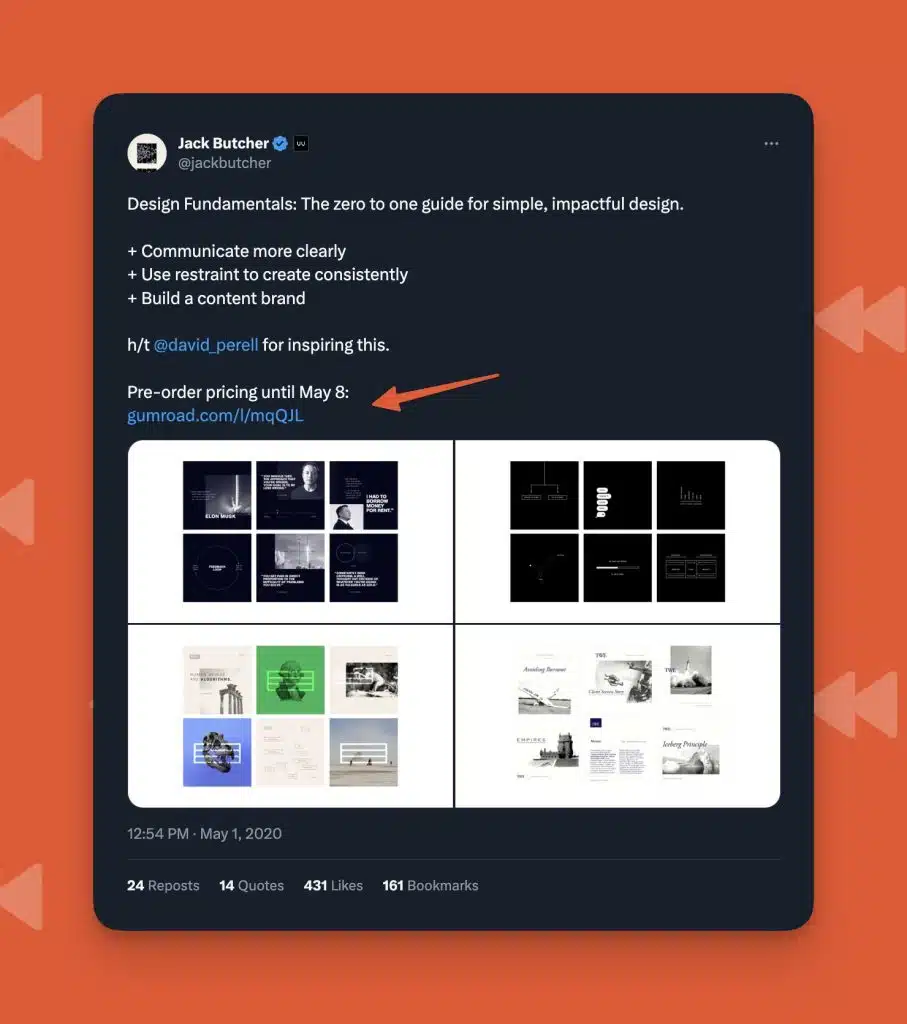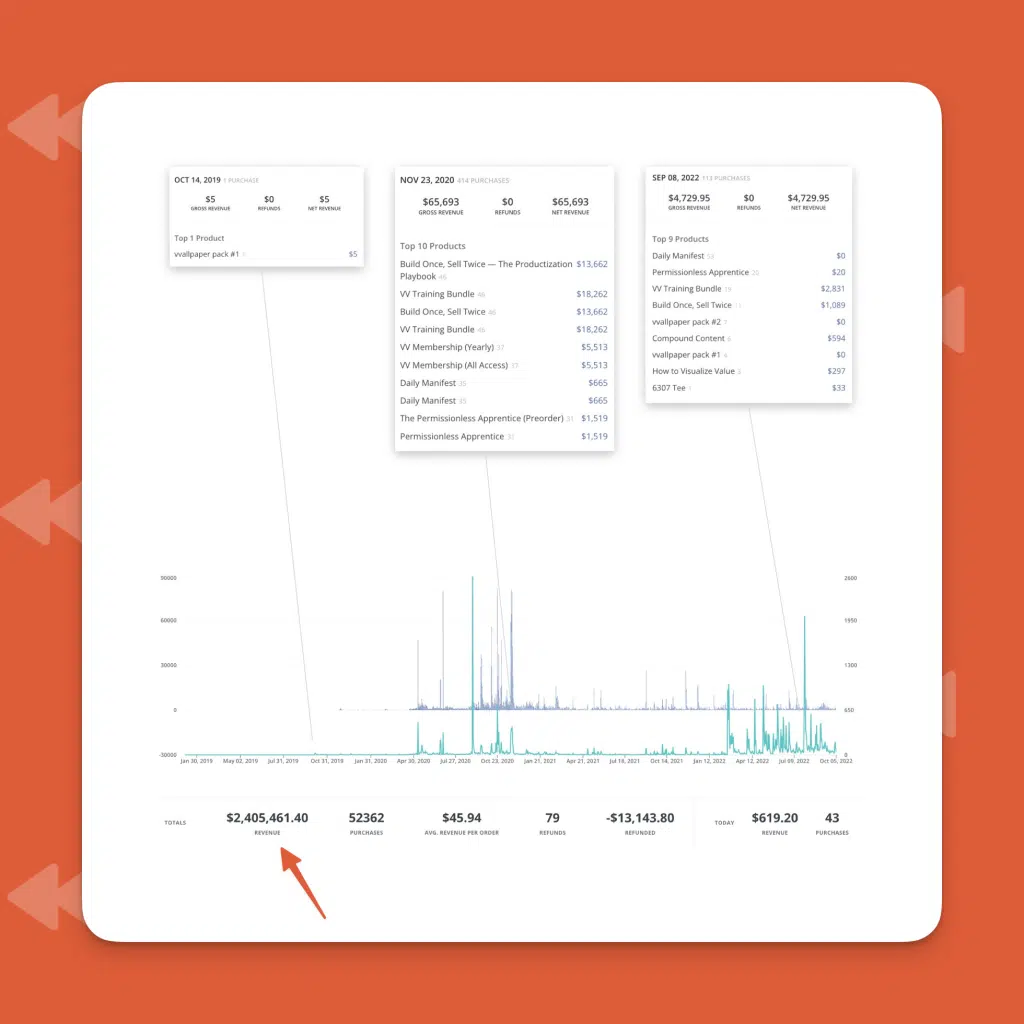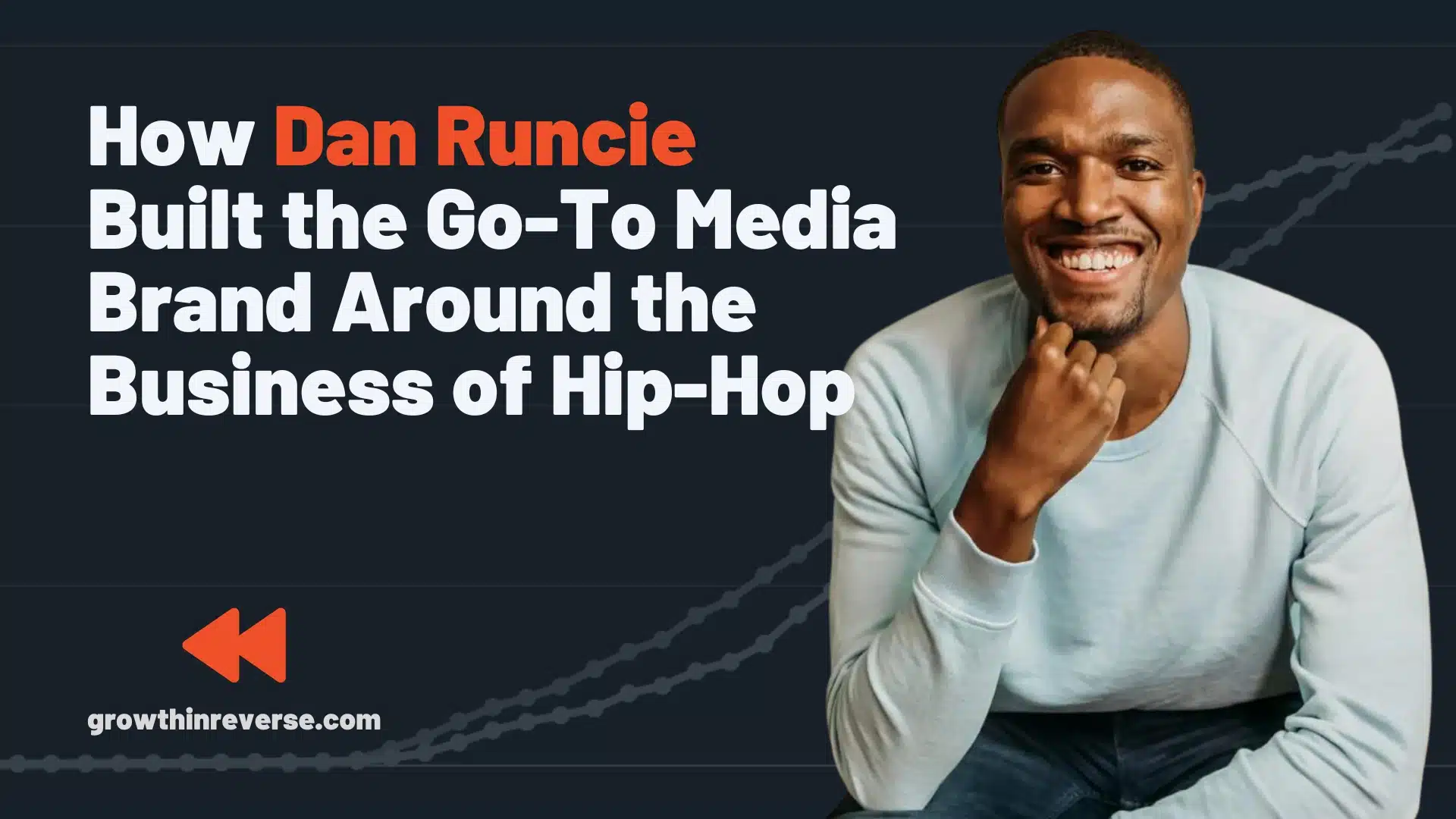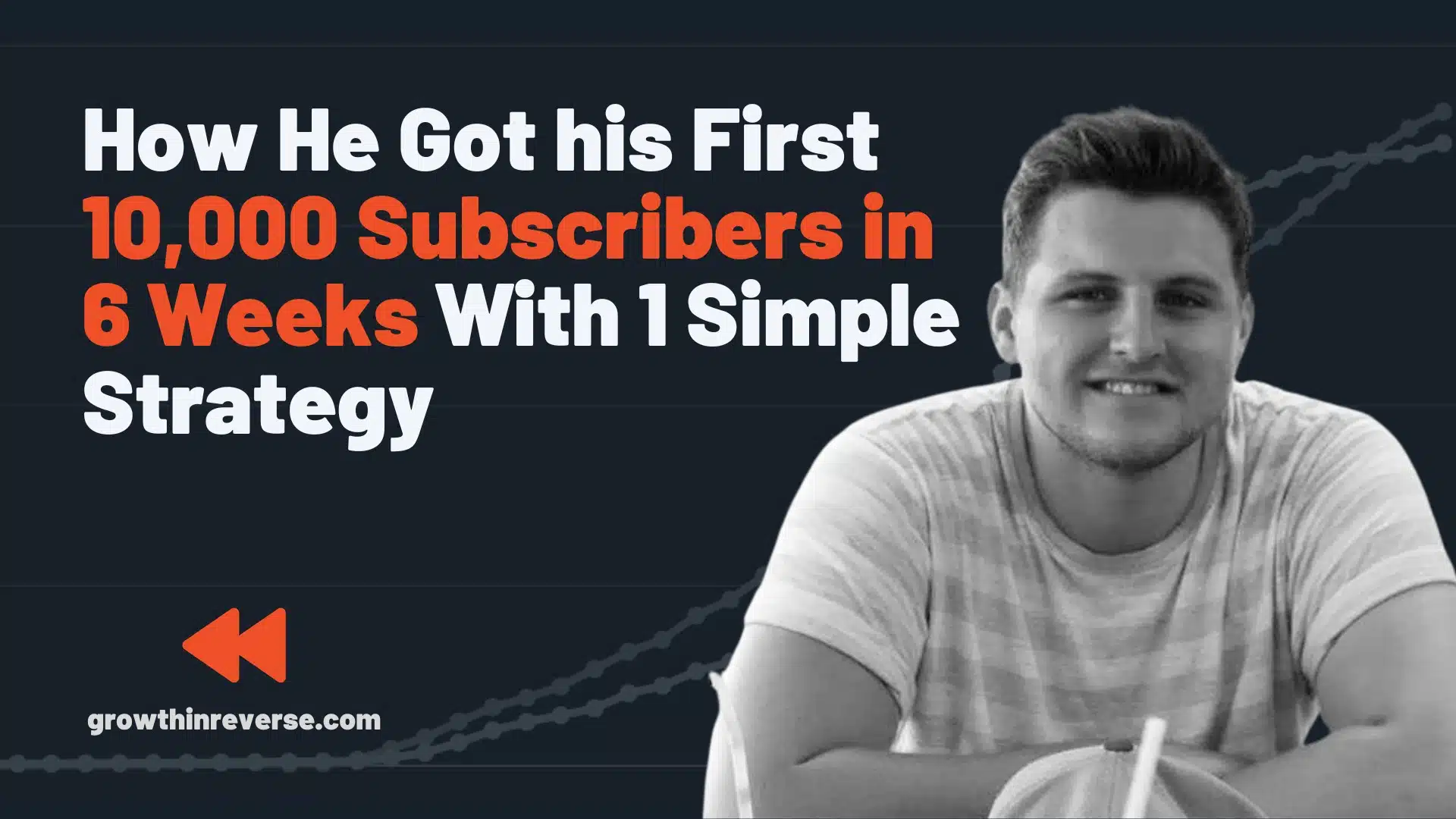Jack Butcher is the man behind Visualize Value, a brand that simplifies business concepts and ideas using visuals.
The brand and simple style has become extremely iconic, leading Jack to amass over 1.2 million followers on social media, while building a wildly successful business teaching others how to do the same.

If you’re not familiar with his work, Jack had been working at advertising agencies for about 10 years.
Through that work and experience, he came to be the “pitch deck” guy, where he’d visualize the businesses of the clients the agency was looking to bring on as clients.
The way he was able to simplify any business model and concepts into super simple, but easy-to-understand visuals was one-of-a-kind.
He ended up leaving his day job in January 2018 to strike it out on his own, building his own agency.
In 2019, he began posting these visuals on social media and the rest is history 🙂
The Growth Timeline
It took Jack Butcher a little time to hit his stride with growing an audience after leaving his job. It wasn’t until March 2020 that his audience started growing at a faster clip.
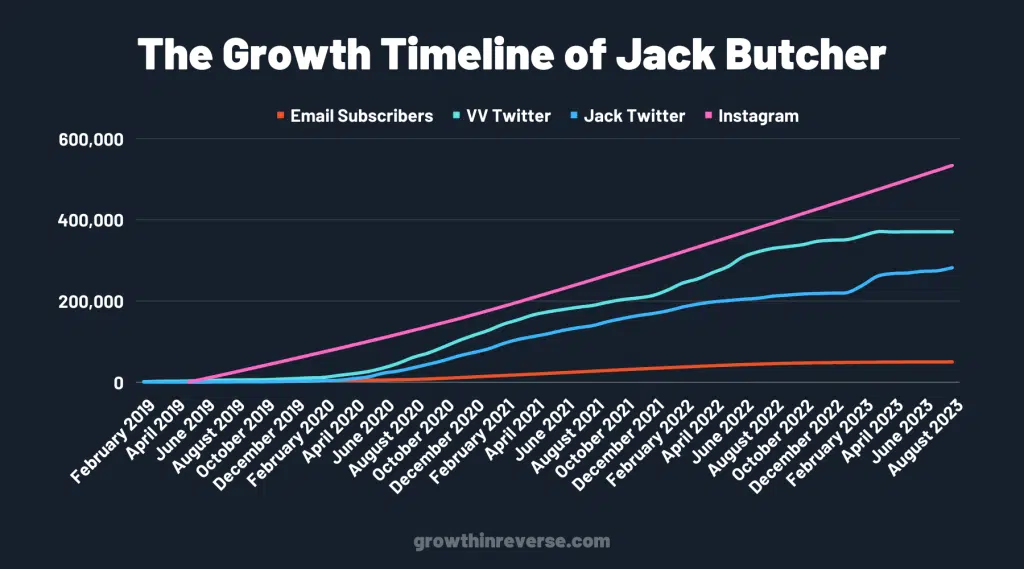
But once he started growing, he didn’t stop. His personal and branded social media profiles have amassed over 1.2 million followers combined.
The 7 Growth Levers of Jack Butcher
So how did he go from relatively unknown, to 1.2 million followers?
He’s used a number of growth levers to built his audience and brand, but there are a few that stand out to me.
1. Creating every day. Jack has been posting new visuals daily since early 2019. But its more than consistency that has grown his audience.
2. Sell your sawdust. Jack’s strategy for showing behind-the-scenes of his work is so simple that it could easily get overlooked.
3. Building courses in public. And the strategies he used to create a course in 7 days, with that initial launch bringing in over $70k.
4. Open vs closed networks. This simple distinction allowed him to realize he was building on the wrong platforms.
5. Constraints = creativity. Forcing yourself to use less time, fonts, colors, and other constraints can build a great breeding ground for creativity.
6. Design forces you to distill. I cannot stop thinking about this one. The act of visualizing concepts has helped him explain things more clearly, and become a leader in the space.
7. Tactical stuff. There are a couple of tactics he’s used that didn’t fit into the other growth levers, but they were extremely interesting and I wanted to share.
1. Creating Every Day
In early 2019, Jack started posting a new visual every single day.
He would take quotes from authors, creatives, and notable people and turn them into simple visuals.
Here is one of the earliest one’s I could find that uses the iconic style we see today.

He credits the consistency of creating every day to something called the Daily UI challenge. Essentially, you would be given prompts to create something for 100 days to get better at the craft of UI and UX design.
While he never stuck with that challenge all the way through the 100 days, it got him into the habit of daily creation.
Do it for the Enjoyment of It
Jack says that he wasn’t creating for other people.
Even if no one else saw his creations, he knew that he was getting better as a designer by creating something every day.
He is adamant about the fact that you need to find something you truly enjoy doing. Something where even if you got no likes on that tweet, or views on the social media post, you would still enjoy making that thing.
Your 100th post isn’t 99+1, it’s 10x
Jack talks quite a bit about how growth isn’t linear.
In a podcast episode with Chris Williamson, Jack said “your 1,001st image isn’t like a +1, it’s like a +150.”
What he means by this is that the network effects speed up as you continue to create and iterate.
If you think of it like a snowball that is rolling down the hill – after a certain inflection point, every inch the snowball moves is drastically more effective and faster than the previous.
You might think that the 100th time you create that thing is just 1x more than the time before…
But as you get better, it’s not a linear graph of how much better your creations are. It’s exponential.

2. Sell Your Sawdust
Jack talks a lot about the concept of selling your sawdust.
You can think of this like building in public, and sharing how you’re building the thing, not just showcasing the final product.
I like the way Jack frames this:
“Continually proving your ability to generate a result is what builds trust with your audience, and drives sales of your products and services.”
Jack Butcher
Proof of Work
When you “sell” your sawdust, you’re creating “proof of work.”
You’re showing potential customers that the finished product of whatever you sell wasn’t just built in a day.
People loving seeing behind-the-scenes of the businesses they love. Creating regularly and showcasing all of the little details behind your main project gets people more and more bought into your ecosystem.
It makes it easier to sell your products because people are already bought into the process and the content you’ve been sharing.
Sell your sawdust, not just the finished work of art.
3. Building Courses in Public
In this vein of selling your sawdust, Jack has built his courses in public for his audience to see.
The first real course he created was called “How to Visualize Value”, and the story behind it makes my creator-brain so happy.
He wasn’t planning on creating a course, it was born out of real demand from people on the internet.
It all started when David Perell posted on Twitter that he really wanted to get better at the skill of creating visuals like Jack Butcher, and tagged him.
Jack thought that was really cool, and retweeted that to gauge interest in other people wanting to learn:
He got a great response from his community, with hundreds of replies.
And so he started building.
2.5 hours later, he posted this:
Talk about just getting started! This went from a seed of an idea, to a product he was pre-selling to validate the idea.
The best/worst part was he was moving so fast, he didn’t realize that Gumroad had a “pro plan” that reduced the transaction fees he’d have to pay.

So he ended up paying quite a bit more than he needed to just because he was trying to get this course out into the world.
“Move fast and break stuff” is a phrase that comes to mind.
Not only did he end up building this in public, but he took advantage of the attention he had in that moment.
The Course Creation
Let’s dig in a bit to see how he went from 0 to $44k in revenue during the initial launch.
After he put up that first tweet, he created a thread about why and how he was going to do this:
At the end, he linked to the pre-order sales page as well.
Then he built the entire course in public and dripped it out to people who bought as it was being created.
He tweeted about the course:
- When he hit 100 pre-orders (tweet)
- After he built the first module (tweet)
- Screenshots of the curriculum outline (tweet)
- When he had some of the slides created (tweet)
- $15k sales in 72 hours (tweet)
- “Build the user interface to your business model” (tweet)
- He shares a breakdown of where the sales traffic is coming from (tweet)
- He did an AMA (tweet)
- Shares that he’s adding templates (tweet)
- Day 4 screenshots (tweet)
- A timelapse video of him builtding a visual on a plane (tweet)
- Day 4/7 recorded video lessons (tweet)
- Day 4/7 – video timelapse of a lesson (tweet)
- Day 5/7 – timelapse of him building a module (tweet)
- Day 6 – David Perell had him on his YouTube channel to do a live creation session (tweet)
- Day 6 – 282 preorders screenshot (tweet)
- Day 7 – tweeted about being excited to release it tomorrow (tweet)
- Day 7 – Tweeted about 441 sales; and leaving preorder pricing up until midnight (tweet)
There are more tweets and replies, but this is the overall breakdown.
Once he got started, he essentially did nothing but build the course and post about it. Such a smart move.
People were even commenting that they loved seeing him build this in real-time.

After launching, he shared some testimonials:
He stopped talking about the course for a few days, and then shared that it doesn’t matter how big your audience is, sales stop after you stop selling:
I’m sharing this because he shows how many sales he made.
Jack made 509 sales and $51,000 in revenue in less than 2 weeks by listening to the needs of the internet, building a product in public in 7 days and releasing it to the world.
Jack did this again with the “Build Once, Sell Twice” course a few months later in July 2020.
This reminds me of how Pat Walls built some of his Starter Story courses.
“Transparency Time”
You might have seen that some of his tweets start with “Transparency time.”
Every few days, Jack posts a transparency time tweet and shares something about his business, from revenue, sales, roadblocks, people plagiarizing his work, etc.
It’s such a simple way to include your community in the building of your work.
4. Pivoting to Open Networks
When he first got started online, Jack was sharing his work on Facebook.
He would share some of the projects he was working on, and was able to drum up business through his Facebook posts.
Jack jokes that only his mom and her friends were commenting on his posts at first. For the longest time, his posts weren’t getting much traction.

Over time, he realized that Facebook is a closed network, where essentially only your friends and connections can see your stuff.
But Twitter was an open network, where thousands of people you’re not even connected to can get introduced to your work.
He started posting his images on Twitter under the handle “scale_trust.”
Eventually, he changed the name to Visualize Value and hasn’t looked back.
That “scale trust” account doesn’t exist anymore, but it’s just another insight into how much Jack has been okay with pivoting.
5. Constraints = Creativity
“Make one decision to save yourself 1,000 decisions.”
Tim Ferriss
In design you can so easily get caught up in picking the right fonts, colors, shades, etc.
After he heard the quote above from Tim Ferriss, he realized that he was spending hours each time he sat down to create just thinking about typefaces.
By constraining himself to black and white and the same font each time, he’s removing that decision. And able to spend that 1-2 hours on actually distilling down the idea and making better visuals.
Constraints make you more creative.
The Art of Simplicity
Many designers pride themselves in choosing the right typefaces, colors, and shapes to convey their idea.
Jack made a critical decision he calls a “happy accident” in the early days of Visualize Value. He realized he was spending hours on every project trying to choose the perfect styles and colors.
Out of a need to simplify and spend less time on each project, he decided he was going to simplify what he allowed himself to use:
- Colors: black, white, and occasionally gray
- Shapes: simple circles, lines, etc
- Font: 1 main font (Rubik)
If you’ve ever logged into Twitter or Instagram, you’ve seen his visuals.
6. Design Forces Him to Distill
While doing this research I realized over and over again that the act of creating a visual forces you to understand the concepts through and through.
When you’re only able to use shapes to explain a big idea, you really have to dig into the meaning of that thing deeply.
It seems like this deep understanding of the work he was doing start when he was working for big ad agencies. His bosses asked him to present the work in client meetings.
This made him very uncomfortable.
Jack said that the only way he would be comfortable sharing his work in front of client was by knowing the business and what he was presenting inside and out.
He would spent hours and hours making the pitch deck perfect so he could present these ideas in a simple way.
This forced him to get really clear on the message and learning about the business. This allowed him to make his work so clear, that it didn’t need a ton of explanation in the meeting.
The act of getting more and more clear over time really honed his skill.
Eliminating the Words
In the early days of his Visualize Value posts, many of them had the quote embedded on the image somewhere. But now, he focuses more on getting the point across without words.
Here is what his earlier posts looked like, with the quote actually embedded on the image.

Now, the words live in the caption, but not on the image.
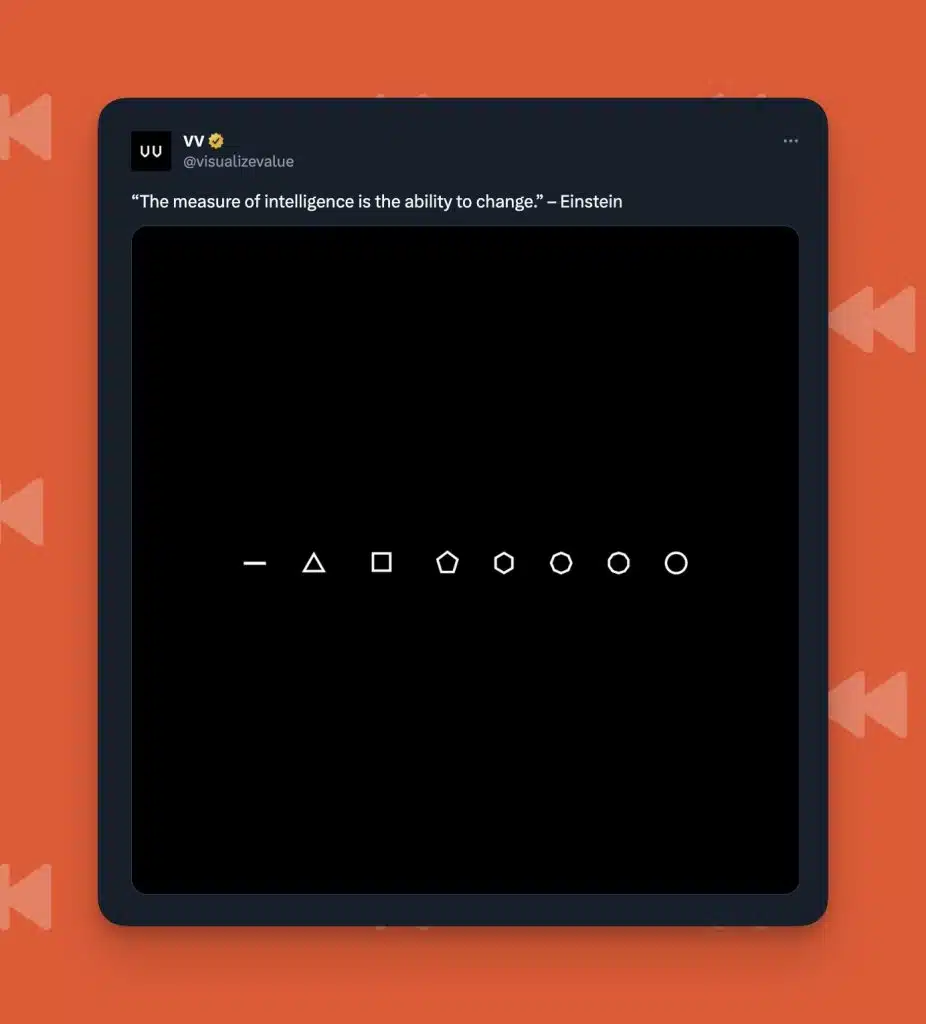
He feels like this is an extra added layer of constraint, making it even more important for him to get his point across using visuals only.
7. Tactical Stuff
There are some more tactical ways Jack has been able to build his business and brand over time.
Product Visuals
For the longest time, Jack had been promoting his products and courses using those standard “product boxes” we see around the internet.

These worked, and everyone else was doing them so they were widely known.
But after a while, he realized that he was creating these incredible visuals for everything, but he wasn’t using them well for his own work.
Eventually, he made the switch over to using visuals to showcase the transformation and value his students would get.
In an interview with Demand Curve, he said that once he did that, “the conversion was exponentially higher.”

He admitted this was a huge blindspot.
Here he was teaching people that visuals are the best way to showcase value, and even he was using a generic image to try and sell those products.
Giveaways
One of the interesting ways he grew his newsletter audience was through “giveaways” on Twitter. But these weren’t the “comment below to get this thing” type of giveaway.
He leaned into the notion of obscurity and mystery around the giveaway. He wasn’t telling people what they would get, just that they would be getting a freebie from him.
This worked extremely well, to the tune of over 2,000 subscribers in 1-2 days.
How You Can Incorporate These Growth Strategies
While we aren’t all going to be great at creating stunning visuals in that way, there are a number of ways we can use some of Jack’s concepts to get better at building our own audiences.
Visualize the Value You’re Providing
After doing this research, I’m a full believer that being able to convey the transformation a customer can go through with your products is key.
Jack has helped all kinds of businesses and entrepreneurs to showcase the value they provide customers. Everything from doctors to lawyers, to “boring” businesses.
So don’t write this one off as something that doesn’t apply to you.
You don’t need to create hundreds of visuals showcasing every aspect of your work. Being able to share a few that show how your business takes people from A to B can be very impactful.
People can understand visuals much faster than words, making them extremely important in the process.
If you’re creating courses or teaching in any way, I think you’re missing a huge opportunity by leaving these out.
Incorporate Constraints
You don’t have to be creating art and visuals to utilize constraints in your work.
This can even be applied to something as simple as your branding. By limiting yourself to 1-2 colors, and 1-2 fonts, you’re eliminating a ton of decisions you might have made otherwise.
Another example is using templates for your articles and newsletters.
Every week I include the same sections in my deep dives, and even though the content ends up being wildly different, the audience still knows what to expect.
You can also limit yourself to a certain word count, like Dru Riley does with Trends.vc. Every report he writes has to be 1,000 words or less.
Using constraints forces you to think outside the box, and focus on what’s actually important to your craft.
Constraints can also be applied to the time you give yourself to create. Or even the platforms you’re creating on.
By constraining yourself in this way, you’re forcing yourself to get more creative on that platform, learn the ins and outs, and master as few things as possible.
Daily Creation
A lot of the well-known creators I’ve researched are extremely prolific, meaning they put out content regularly.
Jack creates a black and white visual every day and publishes it online.
Dickie Bush writes every single day, and it’s been able to help him clarify his thoughts and ideas.
Making yourself create something every day forces you to get better at your craft, and shows your audience you’re serious about building.
At the end of the day
You don’t need to incorporate all of these strategies in order to get something out of this.
Choose one, test it out, and see what works for you.
You can also incorporate multiples of these into one strategy. By selling your sawdust and sharing how you’re creating something, you’ll have more content to post every day.
Give it a shot, and let me know how these work out for you!
